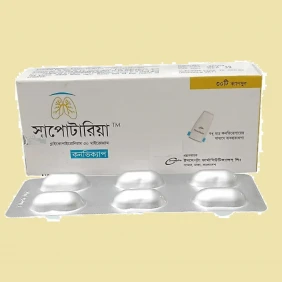
IV/IM Injection Supotaria 0.2 - mg
৳ 50
Quantity:
1
Order By Call:
+88 01540 384 786 (Mobile)
+88 01819 479 004 (WhatsApp)
About the Product
Full Description
\n
\n
\n \n
\n \n
\n \n
\n \n
\nPresentation
\nSupotaria 0.2 mg/ml Injection: Each 1 ml ampoule contains Glycopyrronium Bromide BP 0.2 mg. \n \nSupotaria 0.6 mg/3 ml Injection: Each 3 ml ampoule contains Glycopyrronium Bromide BP 0.6 mg. \n \n \n
\nDescription
\nGlycopyrronium bromide is a quaternary ammonium antimuscarinic with peripheral effects. It is used in anesthetic practice. Given as a premedication before general anesthesia, it diminishes the risk of vagal inhibition of the heart and reduces salivary and bronchial secretions. Intra-operatively, it may be given to reduce bradycardia and hypotension induced by drugs such as suxamethonium, halothane or propofol. Glycopyrronium bromide may be used before or with anticholinesterases such as neostigmine to prevent their muscarinic adverse effects. Antimuscarinic drugs are competitive inhibitors of the actions of acetylcholine at the muscarinic receptors of autonomic effector sites innervated by parasympathetic(cholinergic postganglionic) nerves, as well as being inhibitors of the action of \n \nacetylcholine on smooth muscle lacking cholinergic innervation. Peripheral antimuscarinic effects that are produced as the dose increases are: decreased production of secretions from the salivary, bronchial and sweat glands; dilatation of the pupils (mydriasis) and paralysis of accommodation (cyclopegia); increased heart rate; \n \ninhibition of micturition and reduction in gastrointestinal tone; inhibition of gastric acid secretion. Quaternary ammonium compounds are sparingly lipid soluble and do not readily pass lipid membranes such as the blood-brain barrier. Central effects are negligible. \n \n \n
\nIndications
\nIn Anesthesia: \n \n? As a pre-operative antimuscarinic agent to reduce salivary, tracheobronchial and pharyngeal sections and to reduce the acidity of the gastric contents. \n \n? As a pre-operative or intra-operative antimuscarinic to attenuate or prevent intra-operative bradycardia with the use of suxamethonium or due to cardiac vagal reflexes. \n \n? To protect against the peripheral muscarinic actions of anticholinesterases such as neostigmine and pyridostigmine, used to reverse residual neuromuscular blockade produced by non- depolarizing muscle relaxants. \n \nIn Peptic Ulcer: \n \nFor use in adults as adjunctive therapy for the treatment of peptic ulcer when rapid anticholinergic effect is desired or when oral medication is not tolerated. \n \n \n
\nDosage & Administration
\nFor intramuscular or intravenous administration \nPre-anaesthetic Use \nAdults - 0.2 mg to 0.4 mg intravenously or intramuscularly before the induction of anesthesia. \nAlternatively, a dose of 0.004 to 0.005 mg/kg up to a maximum of 0.4 mg may be used. \nLarger doses may result in profound and prolonged antisialogogue effect, which may be unpleasant for the patient. \nChildren - 1 month to 12 years of age 0.004 to 0.008 mg/kg up to a maximum of 0.2 mg intravenously or intramuscularly before the induction of anesthesia. Larger doses may result in profound and prolonged antisialogogue effect which may be unpleasant for the patient. \nIntraoperative Use \nWhen used to treat arrhythmias associated with traction reflexes, the usual attempts should be made to determine the aetiology of the arrhythmia and the surgical or anesthetic manipulations necessary to correct parasympathetic imbalance should be performed. \nAdults - In those situations where intraoperative use is indicated, a single dose of 0.2 to 0.4 mg (or 0.004 to 0.005 mg/kg up to a maximum of 0.4 mg) by intravenous injection should be used. This dose may be repeated if necessary. \nChildren (1 month to 12 years of age) ? In those situations where intraoperative use is indicated, a single dose of 0.004 to 0.008 mg/kg or up to a maximum of 0.2 mg by intravenous injection should be used. This dose may be repeated if necessary. \nReversal of Neuromuscular Blockade \nAdults - 0.2 mg intravenously per 1 mg neostigmine or the equivalent dose of pyridostigmine. Alternatively, a dose of 0.01-0.015 mg intravenously with 0.05 mg/kg neostigmine or equivalent dose of pyridostigmine. Supotaria may be administered simultaneously from the same syringe with the anticholinesterase; greater cardiovascular \nstability results from this method of administration. \nChildren (1 month to 12 years of age) - 0.01 mg/kg intravenously with 0.05 mg/kg neostigmine or the equivalent dose of pyridostigmine. Supotaria may be administered simultaneously from the same syringe with the anticholinesterase; greater cardiovascular stability results from this method of administration. \n \n \n
\nSide Effects
\nSide effects of antimuscarinics such as glycopyrronium bromide are basically extensions of the fundamental pharmacological action. These include constipation, transient bradycardia (followed by tachycardia, palpitations and arrhythmias), reduced bronchial secretions, urinary urgency and retention, dilatation of the pupils with loss of \naccommodation, photophobia, dry mouth, flushing and dryness of the skin. Side effects that occur occasionally include confusion (particularly in the elderly), nausea, vomiting and giddiness. \nThe following reported adverse reactions are extensions of glycopyrronium bromide?s fundamental pharmacological actions: \nCardiovascular: Tachycardia, ventricular fibrillation, bradycardia, palpitation and arrhythmia, hypertension, hypotension, cardiac arrest, heart block, prolonged QTc interval. \nDermatological: Flushing and inhibition of sweating, severe allergic reactions or drug idiosyncrasies including urticaria and other dermal manifestations, pruritus, dry skin. \nGastrointestinal: Nausea, vomiting, dry mouth, constipation, taste alterations, including loss of taste. \nGenitourinary: Urinary hesitancy and retention, impotence. \nOcular: Blurred vision due to mydriasis, cycloplegia, photophobia, increased ocular tension. \nNervous System: Inhibition of transmission at neuromuscular junction, headache, nervousness, drowsiness, dizziness, seizure, insomnia, some degree of mental confusion, especially in the elderly, hyperexcitability in children. \nPregnancy and perinatal: Suppression of lactation. \nRespiratory System: Respiratory arrest. \nGeneral: Hyperpyrexia bloated feeling, anaphylaxis/anaphylactoid reaction, and hypersensitivity. Injection site reactions including pruritus, oedema, erythema, pain have been reported rarely. \n \n \n
\nPrecautions
\nAntimuscarinics should be used with caution (due to increased risk of side effects) in Down?s syndrome, in children and in the elderly. \nThey should also be used with caution in gastro-esophageal reflux disease, diarrhea, ulcerative colitis, acute myocardial infarction, hypertension, conditions characterized by tachycardia (including hyperthyroidism, cardiac insufficiency, cardiac surgery) because of \nthe increase in heart rate produced by their administration, coronary artery disease and cardiac arrhythmias, pyrexia (due to inhibition of sweating), pregnancy and breast feeding. Because of prolongation of renal elimination, repeated or large doses of glycopyrronium \nbromide should be avoided in patients with uremia. Large doses of quaternary anticholinergic compounds have been shown to block end \nplate nicotinic receptors. This should be considered before using glycopyrronium bromide in patients with myasthenia gravis. \nIt is known that the administration of anticholinergic agents during inhalation anesthesia can result in ventricular arrhythmias. \nUse in elderly and pediatric patients \nPediatric Use \nArrhythmias associated with the use of glycopyrronium bromide intravenously as a premedication or during anesthesia appear to be more likely in pediatric patients than in \nadults. Infants, patients with Down's syndrome and pediatric patients with spastic paralysis or brain damage may experience an increased response to anticholinergics, thus increasing the potential for side effects. A paradoxical reaction characterized by hyperexcitability may occur in pediatric patients taking large doses of anticholinergics including glycopyrronium bromide. Infants and young children are especially susceptible to the toxic effects of anticholinergics. \nSafety and effectiveness of long-term IV use has not been established in pediatric patients. Long-term use of Supotaria is therefore not recommended in pediatric patients. \nElderly Use \nClinical studies of glycopyrronium bromide did not include sufficient numbers of subjects aged 65 years and over to determine whether they respond differently from younger subjects. Other reported clinical experience has not identified differences in responses between elderly and younger patients. In general, dose selection for an elderly patient should be cautious, usually starting at the low end of the dosing range, reflecting greater frequency of decreased hepatic, renal or cardiac function and of concomitant disease or drug therapy. \n \n \n
\nUse in Pregnancy & Lactation
\nData on the use of glycopyrronium bromide in pregnant women, other than on delivery, are not forthcoming, nor is there documentation concerning excretion in breast milk. Although glycopyrronium bromide does not readily cross the placenta, the injection should only be prescribed to pregnant women when clearly necessary. Caution is advised when considering administration to a lactating mother. \n \n \n
\nDrug Interaction
\nMany drugs have antimuscarinic effects; concomitant use of two or more of such drugs can increase side-effects such as dry mouth, urine retention and constipation. Concomitant use can also lead to confusion in the elderly. Anticholinergic agents may delay absorption of other medication given concomitantly. Concurrent administration of anticholingergics and corticosteroids may result in increased \nintraocular pressure. Concurrent use of anticholinergic agents with slow-dissolving tablets of digoxin may cause increased serum digoxin levels. \nRitodrine: tachycardia \nIncreased antimuscarinic side-effects: amantadine; tricyclic antidepressants; antihistamines; clozapine; disopyramaide; \nMAOIs; nefopam; pethidine; phenothiazines (increased antimuscarinic side effects of phenothiazines but reduced plasma \nconcentrations) \nPossibly increased antimuscarinic side-effects: tricyclic (related) antidepressants Domperidone/Metoclopramide: antagonism of effect on gastro-intestinal activity Ketoconazole: reduced absorption of ketoconazole Levodopa: absorption of levodopa possibly reduced Memantine: effects possibly enhanced by memantine \nNitrates: possibly reduced effect of sublingual nitrates (failure to dissolve under the tongue owing to dry mouth) \nParasympathomimetics: antagonism of effect \n \n \n
\nOver Dose
\nGlycopyrronium bromide is a quaternary ammonium agent and symptoms of overdosage are peripheral rather than central in nature. Excessive peripheral anticholinergic effects may be countermanded by giving intravenously a quaternary ammonium anticholinesterase such as neostigmine methylsulphate in increments of 0.25 mg in \nadults. The dose may be repeated every 5 - 10 minutes until anticholinergic over-activity is reversed or up to a maximum of 2.5 mg. Proportionately smaller doses should be used in children. \n \n \n
\nStorage
\nStore below 25?C. \n \n \n
\n





